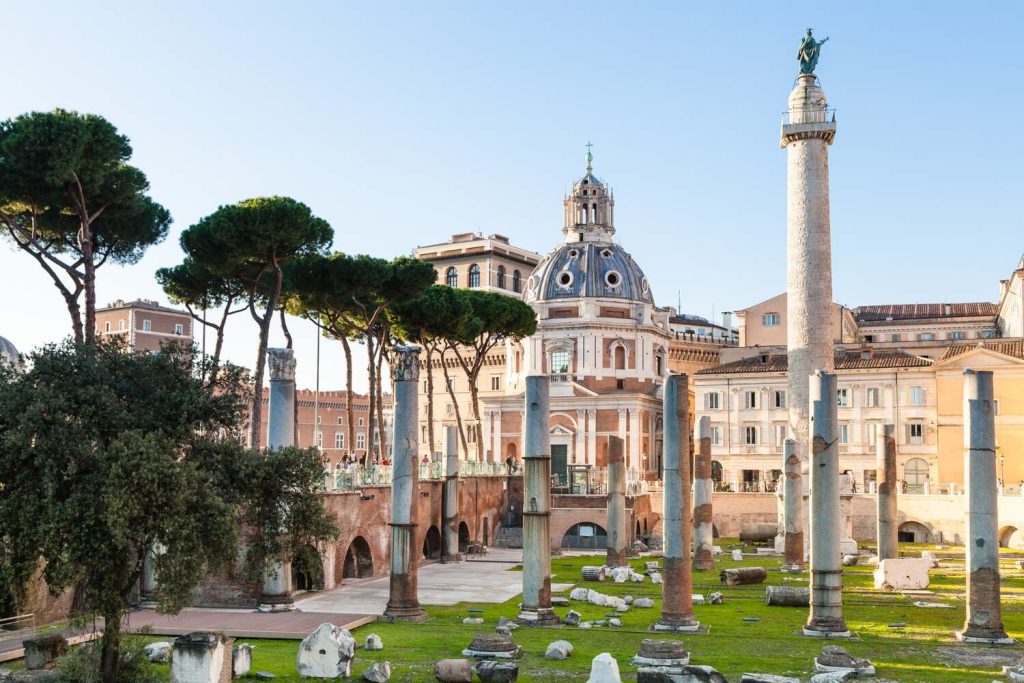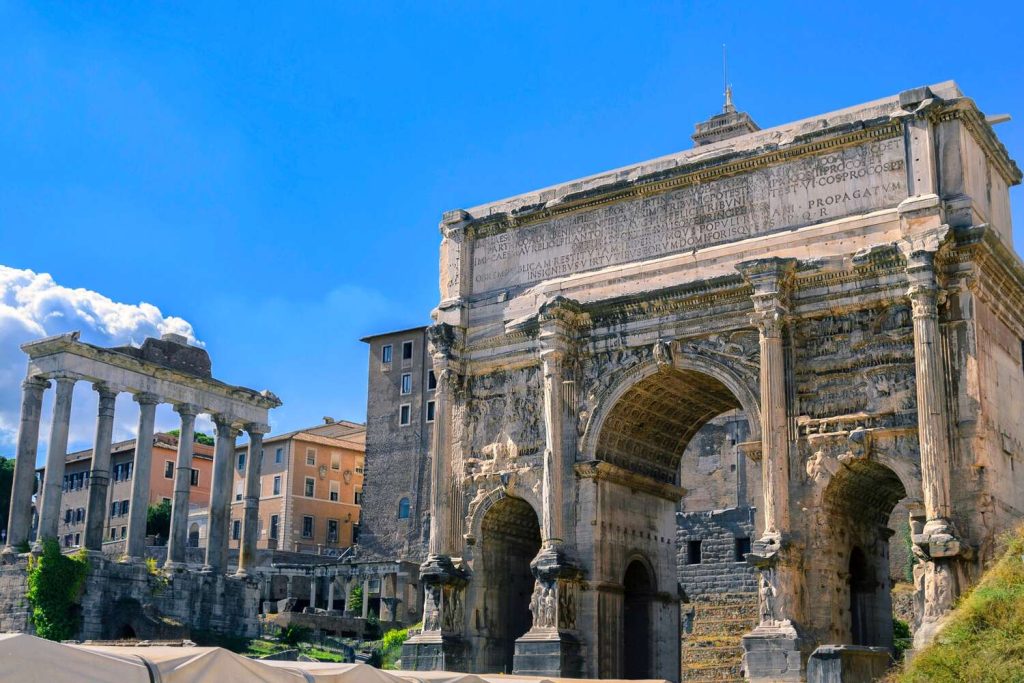Visiting the Roman Forum in Rome: Tickets, Prices, Hours
The Roman Forum is an essential sight to see in Rome, and one of significant archaeology pieces in the world. Here’s tips for planning your trip!
Located within a valley surrounded by the Palatine Hill and Capitoline Hill, the Roman Forum’s is still impressive, just as it must have been centuries ago when it was at the heart of Roman public life.
For over 900 years, the Forum saw buildings, temples and monuments erected, and it was ancient Rome’s core for politics, business and religion.
Many of Rome’s most important buildings, such as the Curia (Senate house), the Temple of Saturn, and the Arch of Septimius Severus, were located in the Roman Forum.
And by the end of this guide, you’ll know everything you must know before visiting!

History of the Roman Forum
The Roman Forum’s location is on the central square of village settlements in the city, which grew over time. The surrounding marshy ground was drained and restored, and numerous construction projects proceeded.
The forum hosted many lavish events. Triumphant parades would arrive in Rome through the triumphal arch, travel around the Palatine Hill, and then continue to the Forum.
After the fall of the Roman Empire in the 5th century, its importance fell into ruins. The area became overgrown and entire structures were destroyed because of neglect instead of being used as a rock quarry.
The material was used to make new palaces, churches, or grave monuments throughout the Renaissance period. After a new road was built, the area was known as Campo Vaccino “cow field” because for centuries cattle owners would pasture their cows there.
The Renaissance saw renewed interest in the Roman Forum when it became the reference point for architects and artist trying to emulate classical antiquity.
Excavations began in the 18th and 19th centuries and continue today.

What to See and Do at the Roman Forum
There are plenty of spectacular items to look at while visiting the Roman Forum, but here’s just a few to get you started!
Arch of Septimius Severus (Arco di Settimio Severo)
Built in 203 AD in honor of Emperor Septimius Severus, the Arch of Severus still stands today and it was designed to celebrate the military victories of Emperor Septimius Severus and his sons.
This marble arch has a height of 23 meters and is covered in intricate carvings that depict scenes from the battles that were won by him and his sons.
Created with a bronze equestrian statue of the Emperor atop the arch, it’s one of the spots you’ll love in the Roman Forum.

Temple of Castor and Pollux
The temples of Castor and Pollux serve as a memory to the twin brothers who were considered protectors of Rome. The structure was initially built in 495 (BC) dedicated to a battle won by Roma and the twins that appeared to have perused the same at the time.
The temple was rebuilt in 6 AD. This became a meeting place for politics and socializing. Now we see three tall columns that remain from its grandeur.

Basilica Aemilia
The Basilica Aemilia was built in 179 BC as a public hall for business and legal matters, providing shelter from the weather. It was rebuilt several times due to fires. The basilica had beautiful marble columns and a central hall with side aisles.
The floor was decorated with colorful mosaics showing scenes from daily Roman life. Today, visitors can see parts of these mosaics and learn about the basilica’s role as a busy center for trade and public affairs, showcasing the organizational skills of ancient Rome.

Column of Phocas
The Column of Phocas, erected in 608 AD, was the last monument added to the Roman Forum. This 13-meter high column was dedicated to the Byzantine Emperor Phocas, who donated it to the city. It originally had a gilded statue of Phocas on top, celebrating his donation of the Pantheon to the Pope.
The column’s base features an inscription honoring Phocas. Visitors find the column interesting for its historical context, as it represents the later use of the Forum, connecting ancient Rome to the medieval period.

Temple of Caesar (Tempio del Divo Giulio)
The Temple of Caesar was built by Augustus in 29 BC and marks the spot where Julius Caesar was cremated. It is dedicated to the comet seen after his death, believed to be his soul rising to the heavens. The temple has a platform with a statue of Caesar.
You can see the ruins and the altar where Caesar was honored, giving a glimpse into the time when Rome changed from a Republic to an Empire.

Temple of Saturn
Historically, Temple of Saturn is considered to be one of the oldest temples of Rome, which was built around 498 BC and dedicated to the God Saturn.
What’s left today is the six columns of the original marble building with its famous pediment a quick reminder of Rome’s classical past.
Also of particular interest to tourist are the religious rites place where the father of the Roman family made offerings and handled the family’s money!
The Temple of Saturn was renovated in 42BC and in the 4th century AD by Rome’s senate.

How to Get to the Roman Forum
The Roman Forum is located in the center of Rome, not far from the Colosseum, and is hard to miss. Here are several ways to visit the Roman Forum:
- By Metro: Line B, Colosseo station
- By Bus: Numbers 51, 75, 81, 85, 87, and 118
- By Tram: Number 30

Prices and Opening Hours of the Roman Forum
All you wanted to know about the Roman Forum in Rome and its history would be incomplete without discussing the opening times and prices of the same.
Opening Hours
- 8:30 AM – 4:30 PM from the last Sunday in October to February 15
- 8:30 AM – 5:00 PM from February 16 to March 15
- 8:30 AM – 5:30 PM from March 16 to the last Saturday in March
- 8:30 AM – 7:15 PM from the last Sunday in March to August 31
- 8:30 AM – 7:00 PM from September 1 to September 30
- 8:30 AM – 6:30 PM from October 1 to the last Saturday in October
- Good Friday: 8:30 AM – 2:00 PM
- June 2: 1:30 PM – 7:15 PM
Note: Access to the Roman Forum is not possible 1 hour before closing. The site is closed on January 1, May 1, and December 25.

Prices
- Combined Ticket for the Colosseum, Roman Forum, and Palatine Hill: €12
- Combined Ticket for the Colosseum + Arena, Roman Forum, and Palatine Hill: €14
We strongly suggest that you book a guided tour as it costs only a little extra and you get to learn Ancient Rome from an expert with better understanding of all things text.
Moreover if you plan to visit the Colosseum, you may want to see the underground, which is restricted to guided tours only, and that is a great addition to your trip to Rome.
READ MORE HERE: Best Tours of the Colosseum and Roman Forum
Conclusion
Simply put, the Roman Forum is a fascinating place for history buffs or anyone with a general curiosity. You will need a guidebook or audio guide in order to understand what different monuments were once used for, but be sure to visit the Forum with plenty of time explore at leisure.
Have a wonderful time as you explore, and discover the stories behind, this impressive work of ancient Rome!






